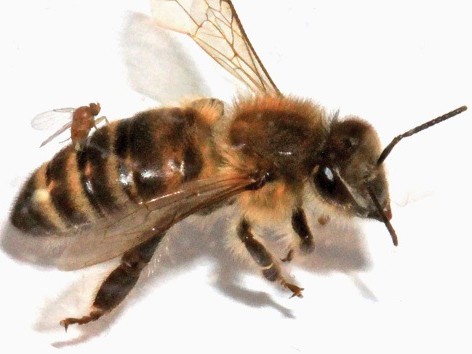The Buzzing Dead: Zombie Bees sighted in Canada

 Zombie bees sighted in Canada?
Zombie bees sighted in Canada?
In a first for Canadian honeybee populations, zombie bees have arrived in Canada, adding one more health concern for an already struggling insect.
Beekeeper Sarah Wallbank from Nanaimo, B.C., recently received confirmation from experts in the United States of the infection, first noticed when some of her honeybees started behaving strangely, becoming disoriented and falling down dead, only to have tiny larvae emerge from their throats and abdomens a short time later.
“There would be a handful of bees that would ping their little brains out against the glass,” said Wallbank. “I thought, ‘This is not normal.’”
The condition is caused by a parasitoid “Zombie Fly” named Apocephalus borealis, common to all parts of North America, the female of which injects its eggs into the abdomen of the bee, leaving them there to hatch and feed on the still-living bee’s brains and insides. The infected bees start exhibiting strange behaviour such as walking in circles, falling over and leaving the hive at unusual times. Once the bee finally dies, the fly larvae emerge five to seven days later.
“It’s just the saddest, weirdest thing,” Wallbank said in conversation with the CBC. “These bees were so frenetic, it’s like somebody agitatedly tapping their fingers on a desk — tap tap tap tap tap.” Wallbank contacted the organization ZomBee Watch, based in San Francisco State University, after noticing the strange behaviour and later received confirmation from Brian Brown, from the Natural History Museum of Los Angeles County that her honey bees were, in fact, zombie bees.
Long known to infect bumble bees and paper wasps throughout North America, A. borealis has only recently been observed attacking honey bees, first in the U.S. Northwest and California and now in B.C., adding yet another scourge to the list currently faced by the honey bee.
Honey bees are currently facing Colony Collapse Disorder, a phenomenon occurring when worker bees inexplicably abandon their hives, which causes stress to both the bee colony and the agricultural industry dependent upon the bees for pollinating crops. Experts have so far identified a number of factors contributing to Colony Collapse, including widespread infection by the varroa mite, loss of habitat and the use of neonicotinoid pesticides, thought to cause health problems for bees dealing with long-term pesticide exposure.
A new long-term study of the impact of neonicotinoid insecticides on wild bee populations in the United Kingdom has confirmed a link between neonicotinoid exposure and increased extinction rates in wild bee populations. The study looked at data on 62 wild bee species over an 18-year period and found that the species which foraged on rapeseed crops -commonly sprayed with neonicotinoids- were on average three times more negatively impacted by the pesticides.
“This supports the hypothesis that the application of this pesticide to oilseed rape is a principle mechanism of exposure for wild bee communities,” say the study’s authors, whose work is published this month in the journal Nature Communications. “A complex array of drivers, from land use to climatic change, may be interacting with neonicotinoid exposure in non-linear ways to affect wild bee population persistence.”

